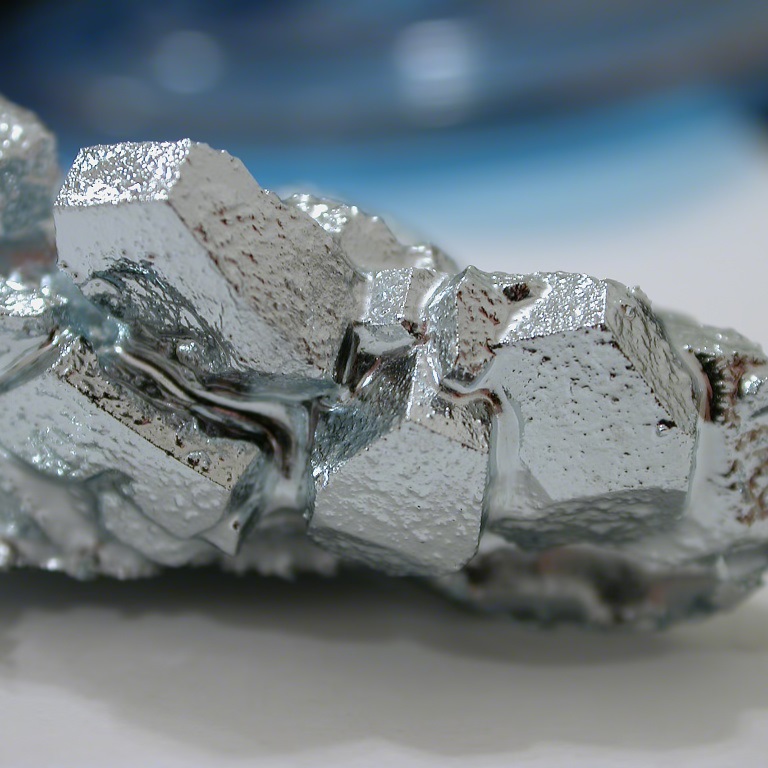Gallium
31
Ga
Group
13
Period
4
Block
p
Protons
Electrons
Neutrons
31
31
39
General Properties
Atomic Number
31
Atomic Weight
69.723
Mass Number
70
Category
Post-transition metals
Color
Silver
Radioactive
No
From the Latin word Gallia, France; also from Latin, gallus, a translation of Lecoq, a cock
Crystal Structure
Base Centered Orthorhombic
History
In 1871, existence of gallium was first predicted by Russian chemist Dmitri Mendeleev and called the element eka-aluminum.
Gallium was discovered spectroscopically by French chemist Paul Emile Lecoq de Boisbaudran in 1875 by its characteristic spectrum in an examination of a sphalerite sample.
Later that year, Lecoq obtained the free metal by electrolysis of its hydroxide in potassium hydroxide solution.
Gallium was discovered spectroscopically by French chemist Paul Emile Lecoq de Boisbaudran in 1875 by its characteristic spectrum in an examination of a sphalerite sample.
Later that year, Lecoq obtained the free metal by electrolysis of its hydroxide in potassium hydroxide solution.
Electrons per shell
2, 8, 18, 3
Electron Configuration
[Ar] 3d10 4s2 4p1
Gallium has a strong tendency to supercool below its melting point / freezing point
Physical Properties
Phase
Solid
Density
5.907 g/cm3
Melting Point
302.91 K | 29.76 °C | 85.57 °F
Boiling Point
2477.15 K | 2204 °C | 3999.2 °F
Heat of Fusion
5.59 kJ/mol
Heat of Vaporization
256 kJ/mol
Specific Heat Capacity
0.371 J/g·K
Abundance in Earth's crust
0.0019%
Abundance in Universe
1×10-6%

CAS Number
7440-55-3
PubChem CID Number
5360835
Atomic Properties
Atomic Radius
135 pm
Covalent Radius
122 pm
Electronegativity
1.81 (Pauling scale)
Ionization Potential
5.9993 eV
Atomic Volume
11.8 cm3/mol
Thermal Conductivity
0.406 W/cm·K
Oxidation States
1, 2, 3
Applications
Gallium wets glass or porcelain and forms a brilliant mirror when it is painted on glass.
It is widely used in doping semiconductors and producing solid-state devices such as transistors.
Low melting gallium alloys are used in some medical thermometers as non-toxic substitutes for mercury.
Gallium arsenide is capable of converting electricity directly into coherent light.
It is widely used in doping semiconductors and producing solid-state devices such as transistors.
Low melting gallium alloys are used in some medical thermometers as non-toxic substitutes for mercury.
Gallium arsenide is capable of converting electricity directly into coherent light.
Gallium is considered to be non-toxic
Isotopes
Stable Isotopes
69Ga, 71GaUnstable Isotopes
56Ga, 57Ga, 58Ga, 59Ga, 60Ga, 61Ga, 62Ga, 63Ga, 64Ga, 65Ga, 66Ga, 67Ga, 68Ga, 70Ga, 72Ga, 73Ga, 74Ga, 75Ga, 76Ga, 77Ga, 78Ga, 79Ga, 80Ga, 81Ga, 82Ga, 83Ga, 84Ga, 85Ga, 86Ga